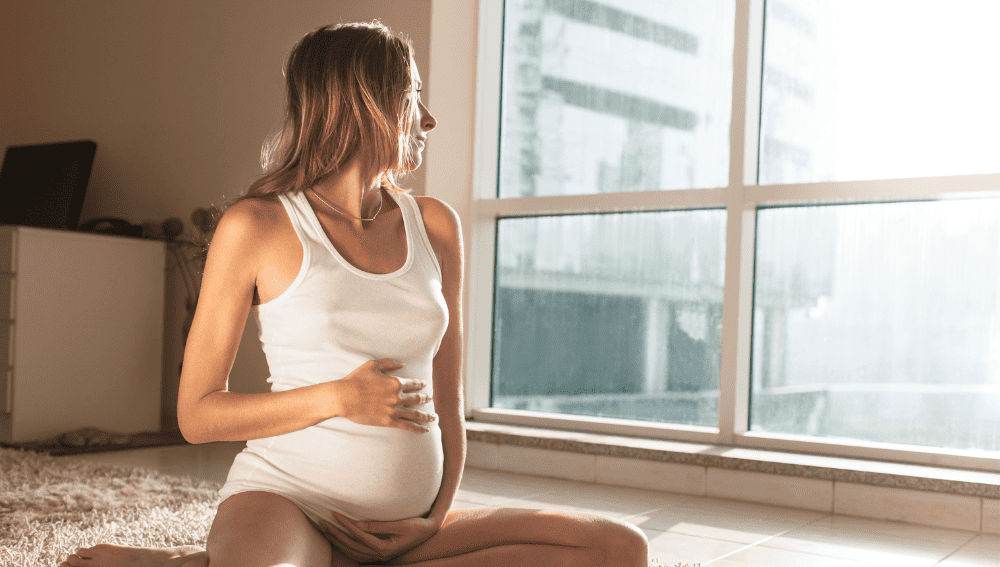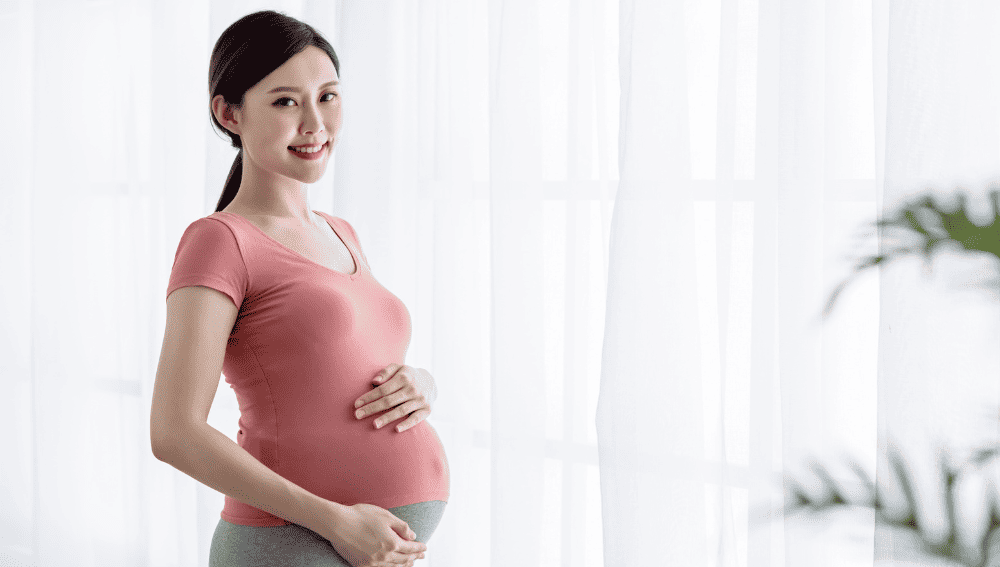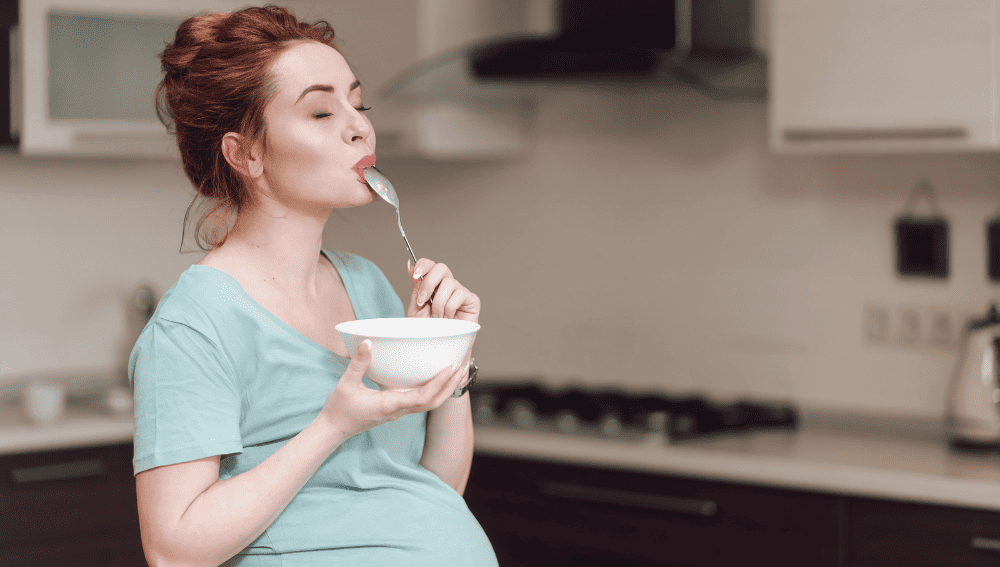At 13 weeks pregnant, many women may expect their bellies to feel firm or hard, but instead, they may notice their bellies still feel soft.
This can be a cause for concern or confusion, especially for first-time mothers. However, a soft belly at 13 weeks pregnant is not necessarily a sign of a problem.
Understanding the changes that occur during the 13th week of pregnancy can help explain why a woman’s belly may still feel soft. At this stage, the baby is still small and is growing rapidly, but the uterus is not yet large enough to cause a noticeable change in the shape or firmness of the belly.
Additionally, hormonal changes in the body can cause bloating, which can make the belly feel softer than usual.
It’s important to note that every pregnancy is unique, and a woman’s belly may feel different at different stages of pregnancy. However, if there are any concerns or unusual symptoms, it’s important to speak with a healthcare provider.
Understanding the 13th Week of Pregnancy
At 13 weeks pregnant, a woman is in the first trimester of pregnancy. This is a crucial time for the development of the fetus, and it is important for the mother to take care of herself and her growing baby.
During the 13th week of pregnancy, the fetus is about the size of a peach. At this stage, the baby’s major organs have formed, and the baby is starting to develop its own unique fingerprints.
The mother may start to feel more energized as the fatigue of the first trimester starts to subside.
One concern that some women may have at 13 weeks pregnant is that their belly is still soft. However, this is completely normal. The uterus is still small and hasn’t yet expanded enough to cause the belly to harden.
It’s important for women to continue to take care of themselves during the first trimester and beyond. This includes eating a healthy diet, staying hydrated, and getting plenty of rest.
It’s also important to attend regular prenatal appointments with a healthcare provider to monitor the health of the mother and the growing baby.
As the first trimester comes to a close, the mother will soon enter the second trimester of pregnancy. This is a time of continued growth and development for the baby, and the mother may start to feel more movement as the baby becomes more active.
Overall, the 13th week of pregnancy is an exciting time as the baby continues to grow and develop. While some women may be concerned about the softness of their belly, this is completely normal at this stage of pregnancy.
With proper care and attention, the mother and baby can continue to thrive throughout the pregnancy.
Physical Changes in the Body
At 13 weeks pregnant, a woman’s body is going through many physical changes. These changes are a normal part of pregnancy and are necessary for the growth and development of the fetus.
Some of the most common changes that a woman may experience at this stage include weight gain, swelling, back pain, tender breasts, abdominal muscles, stretch marks, an expanding uterus, and changes in body shape.
One of the most noticeable changes during pregnancy is the pregnant belly. At 13 weeks, the belly may not be very noticeable, and it may still be soft to the touch.
However, as the baby grows, the belly will become more prominent, and the abdominal muscles will stretch and weaken, causing the belly to become firmer.
Weight gain is also a common physical change during pregnancy. At 13 weeks, a woman may have gained a few pounds, but the majority of the weight gain will occur later in the pregnancy.
It is important to gain weight during pregnancy to provide the necessary nutrients for the growing fetus.
Swelling is another common physical change during pregnancy. This is caused by an increase in blood volume and can occur in the feet, ankles, and hands. It is important to stay hydrated and to avoid standing or sitting for long periods of time to prevent swelling.
Back pain is also common during pregnancy, especially in the later stages. This is caused by the weight of the growing baby and the changes in the body’s center of gravity. It is important to maintain good posture and to exercise regularly to prevent back pain.
Tender breasts are another common physical change during pregnancy. This is caused by hormonal changes in the body and is a normal part of pregnancy. Wearing a supportive bra can help alleviate discomfort.
Abdominal muscles may also become weaker during pregnancy, causing the belly to protrude more. It is important to exercise regularly to strengthen these muscles and to maintain good posture.
Stretch marks may also appear during pregnancy, especially on the belly, breasts, and thighs. These are caused by the stretching of the skin and are a normal part of pregnancy. Using moisturizers and staying hydrated can help prevent stretch marks.
Finally, the uterus will continue to expand during pregnancy, causing changes in body shape. It is important to wear comfortable clothing and to stay active to maintain a healthy body shape during pregnancy.
Symptoms and Signs at 13 Weeks
At 13 weeks pregnant, most women are now in the second trimester and may be experiencing a relief from some of the early pregnancy symptoms. However, there are still some symptoms that may persist or even worsen.
Nausea and morning sickness may still be present for some women, but it typically subsides by the end of the first trimester. Food aversions may also continue, and some women may experience heartburn and indigestion due to the growing uterus putting pressure on the stomach.
Energy levels may start to increase, but fatigue is still common due to the body working hard to support the growing baby. Constipation and gas may also persist, and urinary tract infections (UTIs) are still a concern.
Leg cramps and nosebleeds may occur, and shortness of breath may become more noticeable as the uterus continues to grow and press on the diaphragm. Cramping may also occur as the uterus stretches and expands.
Visible veins, including varicose veins, may become more prominent due to the increased blood volume in the body. Frequent urination is also common as the growing uterus puts pressure on the bladder.
It is important to note that every pregnancy is different, and symptoms can vary from woman to woman. If any symptoms are severe or concerning, it is important to consult with a healthcare provider.
Baby’s Development at 13 Weeks
At 13 weeks, the baby is about the size of a peach and is developing rapidly. Here are some of the key developments happening during this week:
Movement
The baby is starting to move around more, although the mother may not yet be able to feel these movements. The baby’s arms and legs are growing longer and becoming more defined, and the baby is starting to develop its own unique pattern of movements.
Amniotic Fluid
The baby is surrounded by amniotic fluid, which helps to cushion and protect it. At 13 weeks, the baby is producing more urine, which is helping to replenish the amniotic fluid.
Placenta
The placenta is continuing to grow and develop, and is providing the baby with essential nutrients and oxygen. The placenta is also helping to remove waste products from the baby’s blood.
Baby Bump
At 13 weeks, some women may start to notice a small baby bump. However, for many women, the belly may still feel soft and not noticeably different from before.
Baby’s Position
The baby is starting to move around and change positions more frequently. However, at this stage, the baby is still small enough that it has plenty of room to move around.
Movements
The baby is starting to develop more coordinated movements, and may even be able to suck its thumb or make a fist.
Week 13
At 13 weeks, the baby is about 3 inches long and weighs around 0.8 ounces. The baby’s organs are continuing to develop and mature, and the baby is starting to produce its own red blood cells.
Gender
Although it is still too early to determine the baby’s gender through ultrasound, the baby’s genitals are starting to develop.
Swallowing
The baby is starting to practice swallowing, which is an important skill that will be needed after birth.
Fingerprints
The baby’s fingerprints are starting to form, which will be unique to the baby and will remain the same throughout its life.
Diet and Nutrition
Maintaining a healthy diet is crucial during pregnancy, especially during the first trimester. Eating a balanced diet that includes whole grains, fresh fruits, vegetables, and protein is essential to ensure the proper growth and development of the fetus.
It is recommended that pregnant women consume at least five servings of fruits and vegetables daily. These foods are rich in vitamins, minerals, and fiber, which are necessary for the healthy development of the baby.
Additionally, consuming whole grains, such as brown rice and whole wheat bread, can provide essential nutrients like iron and folic acid.
Protein is also essential during pregnancy. It is recommended that pregnant women consume at least 70 grams of protein daily. Some good sources of protein include lean meat, poultry, fish, beans, and nuts.
Incorporating citrus fruits, like lemons, into the diet can also be beneficial. Citrus fruits are rich in vitamin C, which can help boost the immune system and aid in the absorption of iron.
In summary, maintaining a healthy diet and consuming a variety of foods is crucial during pregnancy.
By incorporating a variety of fruits, vegetables, whole grains, and protein into their diet, pregnant women can ensure that they are providing their baby with the necessary nutrients for healthy growth and development.
Understanding Soft Belly
During pregnancy, many women experience a soft belly, which can be concerning for some. However, a soft belly during pregnancy is quite common and is not necessarily a cause for concern.
In fact, it is completely normal for the belly to remain soft during the early stages of pregnancy.
The uterus is a muscle, and during pregnancy, it begins to stretch and expand to accommodate the growing fetus.
As a result, the abdominal muscles may become stretched and weakened, leading to a soft belly. Additionally, hormonal changes during pregnancy can also contribute to a soft belly.
It is important to note that a soft belly during pregnancy does not necessarily indicate a problem with the pregnancy.
However, if a woman experiences sudden changes in the texture or size of her belly, or if she experiences pain or discomfort, she should consult with her healthcare provider.
Overall, a soft belly during pregnancy is a normal and common occurrence. It is important for women to understand that their bodies are going through significant changes during pregnancy, and a soft belly is just one of these changes.
By staying informed and seeking medical advice when necessary, women can ensure a healthy and successful pregnancy.
Hormonal Changes
During pregnancy, hormonal changes occur in a woman’s body to support the growth and development of the fetus. The hormone responsible for maintaining pregnancy is progesterone, which is produced by the ovaries and placenta.
Progesterone helps to thicken the lining of the uterus and prevents it from shedding, which would cause a miscarriage.
As the pregnancy progresses, the level of progesterone in the body increases significantly. This increase in progesterone can cause a variety of symptoms, including fatigue, mood swings, and nausea. It can also cause the muscles in the digestive tract to relax, leading to constipation and heartburn.
Additionally, pregnancy hormones such as human chorionic gonadotropin (hCG) and estrogen also play a role in supporting the pregnancy. hCG is produced by the placenta and is responsible for maintaining the corpus luteum, which produces progesterone.
Estrogen, on the other hand, helps to maintain the pregnancy by increasing blood flow to the uterus and promoting the growth of the fetus.
Overall, hormonal changes during pregnancy are necessary for a healthy pregnancy and fetal development. However, they can also cause a variety of symptoms and discomforts for the mother-to-be.
Pregnancy with Multiples
Pregnancy with multiples, such as twins or more, can be a unique experience for expectant mothers.
It is important to note that every pregnancy is different, and the experience of carrying multiples can vary greatly depending on a number of factors, including the number of babies, their individual sizes and positions, and the mother’s overall health.
One of the most notable differences in a multiple pregnancy is the size of the belly. Many women carrying twins or more will have a larger belly earlier on in their pregnancy than those carrying a single baby.
This is because the uterus must stretch to accommodate multiple babies, which can cause the belly to appear larger and more pronounced.
In addition to a larger belly, women carrying multiples may experience more intense pregnancy symptoms, such as fatigue, nausea, and back pain. This is due to the increased demands placed on the body to support multiple fetuses.
It is important for expectant mothers carrying multiples to take extra care of themselves during pregnancy, including getting plenty of rest, eating a healthy diet, and staying hydrated.
Overall, pregnancy with multiples can be a challenging but rewarding experience. With proper care and monitoring, many women are able to successfully carry and deliver healthy twins, triplets, or more.
Healthcare and Checkups
During pregnancy, it is crucial to receive regular prenatal care. A healthcare provider, such as a doctor or midwife, can help ensure the health of both the mother and the developing fetus.
At 13 weeks pregnant, it is recommended that the mother schedule her first prenatal visit if she has not already done so.
During this visit, the healthcare provider will perform a physical exam and may order blood tests to check for any potential health concerns. The provider will also discuss the mother’s medical history and any current medications she is taking.
In subsequent prenatal visits, the healthcare provider will monitor the mother’s weight gain, blood pressure, and the growth and development of the fetus.
The provider will also discuss any symptoms or concerns the mother may have and provide guidance on nutrition, exercise, and other aspects of prenatal care.
It is important for the mother to attend all scheduled prenatal visits and to communicate any changes or concerns with her healthcare provider. Regular checkups can help ensure a healthy pregnancy and delivery.
Exercise and Physical Activity
Regular exercise and physical activity can help pregnant women maintain a healthy weight, reduce stress, and improve overall well-being.
However, it is important to consult with a healthcare provider before starting any new exercise routine.
During the first trimester, many women may not see a significant change in their belly size, and it may still feel soft to the touch. This is normal and does not necessarily indicate a problem.
Some recommended exercises for pregnant women include:
- Walking: A low-impact exercise that can be done almost anywhere.
- Swimming: A great way to stay active while reducing stress on the joints.
- Yoga: Can help improve flexibility and relaxation.
- Strength training: Can help maintain muscle tone and prepare the body for labor.
It is important to listen to your body and not push yourself too hard during exercise. It is also recommended to avoid exercises that involve lying on the back for extended periods of time, as this can reduce blood flow to the uterus.
Overall, regular exercise and physical activity can have many benefits for pregnant women. However, it is important to consult with a healthcare provider and make modifications as necessary to ensure a safe and healthy pregnancy.
Understanding Belly Firmness
During pregnancy, the uterus grows rapidly, causing changes in the appearance and feel of a woman’s belly.
As the uterus expands, the skin and muscles around it stretch to accommodate the growing fetus. This can cause the belly to feel firmer than usual, especially in the second and third trimesters.
However, some women may experience a soft belly during pregnancy, even as their uterus continues to grow.
This can be concerning, but it’s not always a cause for alarm. Here are a few reasons why a pregnant woman’s belly may feel soft:
- Early pregnancy: During the first few weeks of pregnancy, the uterus is still small and hasn’t yet begun to expand. As a result, a woman’s belly may not feel noticeably firmer.
- Body type: Women with a larger body type may not notice a significant change in the firmness of their belly during pregnancy. This is because their abdominal muscles are already stretched out, making it more difficult to feel the difference.
- Position of the fetus: The position of the fetus can also affect the firmness of a woman’s belly. If the baby is positioned towards the back of the uterus, it may not push against the abdominal wall as much, causing the belly to feel softer.
It’s important to note that a soft belly during pregnancy doesn’t necessarily indicate a problem. However, if a woman experiences other symptoms, such as vaginal bleeding or cramping, she should contact her healthcare provider immediately.
In conclusion, the firmness of a pregnant woman’s belly can vary depending on a number of factors. While a soft belly may be concerning, it’s not always a cause for alarm.
If a woman has any concerns about the firmness of her belly or other symptoms during pregnancy, she should consult her healthcare provider.
Pregnancy Clothing
As a woman’s body undergoes changes during pregnancy, it is important to choose clothing that is comfortable and supportive. Maternity clothes are designed to accommodate a growing belly and provide comfort during this time.
One of the most important things to consider when choosing pregnancy clothing is the fabric. Soft and stretchy fabrics like cotton and spandex are ideal for accommodating a growing belly.
These fabrics are also breathable, which can help prevent overheating and discomfort.
Maternity clothes come in a variety of styles, from casual to formal wear. For casual wear, maternity leggings and stretchy tops are a popular choice.
These items are comfortable and can be dressed up or down depending on the occasion. Maternity jeans with an elastic waistband are also a great option for everyday wear.
For formal occasions, maternity dresses and skirts are available in a range of styles and fabrics. Empire waist dresses are a popular choice as they provide room for a growing belly while still looking stylish. Maternity gowns are also available for more formal events.
It is important to note that not all maternity clothes are created equal. Some items may be more supportive and comfortable than others.
It is recommended to try on different styles and brands to find what works best for you. Additionally, investing in a few key pieces that can be mixed and matched can help save money and provide a variety of outfit options.
Overall, choosing comfortable and supportive pregnancy clothing can help alleviate discomfort and make this special time more enjoyable.
Understanding Labor Signs
As a woman approaches her due date, she may start to experience various signs of labor. Some of these signs may be confusing, and it can be difficult to know when labor is truly starting.
In this section, we will discuss the different types of labor signs and what they mean.
Round Ligament Pain
Round ligament pain is a common discomfort during pregnancy. It is caused by the stretching of the round ligaments that support the uterus.
This pain is usually felt as a sharp, stabbing sensation on one or both sides of the lower abdomen. It can be more noticeable when changing positions, coughing, or sneezing.
Braxton Hicks Contractions
Braxton Hicks contractions are also known as false labor contractions. They are usually painless and irregular, and they do not increase in intensity or frequency.
These contractions can start as early as the second trimester, but they are more common in the third trimester. Braxton Hicks contractions are a sign that the uterus is preparing for labor.
True Labor Contractions
True labor contractions are regular, painful contractions that become more intense and frequent over time. These contractions are a sign that the cervix is dilating and effacing.
True labor contractions usually start in the lower back and move to the front of the abdomen. They may also be accompanied by a bloody show or the release of the mucus plug.
Real Labor
Real labor is when the contractions are strong, regular, and do not go away with rest or hydration. This is a sign that the baby is on its way and that labor is progressing. Real labor contractions usually last between 30 and 60 seconds and occur every 5 to 10 minutes.
False Labor
False labor is when the contractions are irregular and do not increase in intensity or frequency. These contractions may be uncomfortable, but they do not lead to the birth of the baby. False labor contractions may be caused by dehydration, physical activity, or a full bladder.
In conclusion, understanding the different types of labor signs can help a woman prepare for the birth of her baby. By recognizing the signs of true labor, she can make sure that she gets to the hospital or birthing center in time.
Breast Changes
At 13 weeks pregnant, many women start to notice changes in their breasts. These changes are due to hormonal fluctuations, and they are a normal part of pregnancy.
One of the most noticeable changes is an increase in breast size. As the body prepares for breastfeeding, the breasts may become larger, fuller, and more tender. The areolas (the dark area around the nipples) may also darken and become more sensitive.
In addition to these changes, some women may notice that their breasts start to produce colostrum. Colostrum is a thick, yellowish fluid that is the first milk produced by the breasts. It is rich in nutrients and antibodies, and it is important for a newborn’s immune system.
While some women may find colostrum leakage to be uncomfortable or embarrassing, it is a normal part of pregnancy. Nursing pads can be used to absorb any leakage.
It is important to note that breast changes during pregnancy do not necessarily indicate a woman’s ability to breastfeed.
While some women may experience more noticeable changes than others, the ability to breastfeed is determined by a variety of factors, including the baby’s ability to latch and the mother’s milk supply.
Overall, breast changes during pregnancy are a normal and natural part of the process. By understanding what to expect, women can feel confident and prepared for the changes to come.
Dental Health in Pregnancy
Maintaining good dental health during pregnancy is important for both the mother and the baby.
Hormonal changes during pregnancy can increase the risk of dental problems such as gum disease and tooth decay. It is important to take extra care of your teeth and gums during this time.
Pregnant women should continue to brush their teeth twice a day with fluoride toothpaste and floss daily. They should also visit their dentist regularly for checkups and cleanings.
Dental x-rays should be avoided during pregnancy unless they are absolutely necessary.
Calcium is important for the development of healthy teeth and bones. Pregnant women should ensure they are getting enough calcium in their diet by consuming dairy products, leafy greens, and fortified foods. Calcium supplements may also be recommended by a healthcare provider.
If a pregnant woman experiences any dental problems such as toothache or bleeding gums, she should contact her dentist right away. Delaying treatment can lead to more serious problems and potentially harm the baby.
Overall, maintaining good dental health during pregnancy is essential for both the mother and the baby. By following good oral hygiene practices and seeking prompt treatment for any dental problems, pregnant women can help ensure a healthy pregnancy and a healthy baby.
Understanding Pregnancy Cravings
Pregnancy cravings are a common phenomenon experienced by many women during pregnancy. These cravings can be for a specific type of food or a particular dish.
Some women may crave sweet foods, while others may crave salty or spicy foods. It is essential to understand that cravings are a normal part of pregnancy and are not necessarily a sign of a nutritional deficiency.
Food Cravings
Food cravings are a common symptom of pregnancy. These cravings are often for foods that a woman may not have enjoyed before or that are not part of her regular diet.
It is not clear why women experience food cravings during pregnancy, but it is believed that hormonal changes may play a role.
Cravings and Food Aversions
In addition to food cravings, some women may also experience food aversions during pregnancy. These aversions can be for specific foods or entire food groups.
It is essential to listen to your body and avoid foods that make you feel nauseous or uncomfortable.
Conclusion
In conclusion, pregnancy cravings are a normal part of pregnancy and are not necessarily a sign of a nutritional deficiency. It is essential to listen to your body and avoid foods that make you feel uncomfortable.
If you have any concerns about your pregnancy cravings or aversions, it is always best to speak with your healthcare provider.
Pregnancy Complications
Pregnancy is an exciting time for many women, but it can also come with complications. Some of these complications can be serious and require prompt medical attention.
It’s important to be aware of the signs and symptoms of these complications to ensure the health and safety of both the mother and baby.
Preeclampsia
Preeclampsia is a serious condition that can occur during pregnancy, typically after 20 weeks. It’s characterized by high blood pressure and damage to organs such as the liver and kidneys. Symptoms of preeclampsia can include:
- Swelling of the hands and face
- Headaches
- Vision changes
- Upper abdominal pain
- Nausea or vomiting
If left untreated, preeclampsia can lead to complications such as premature birth, low birth weight, and even maternal and fetal death. Treatment for preeclampsia may include medication to lower blood pressure and close monitoring of the mother and baby.
Urinary Tract Infection
Urinary tract infections (UTIs) are common during pregnancy and can be caused by bacteria entering the urinary tract. Symptoms of a UTI can include:
- Pain or burning during urination
- Frequent urination
- Cloudy or strong-smelling urine
- Pelvic pain or pressure
If left untreated, a UTI can lead to more serious complications such as kidney infection and premature labor. Treatment for UTIs during pregnancy typically involves antibiotics and increased fluid intake.
It’s important for pregnant women to attend all prenatal appointments and communicate any concerns or symptoms with their healthcare provider. With proper care and monitoring, many complications can be successfully managed to ensure a healthy pregnancy and delivery.
Frequently Asked Questions
Is it normal to not feel pregnant at 13 weeks?
Yes, it is normal to not feel pregnant at 13 weeks. Some women may not experience any symptoms or may have mild symptoms during the first trimester.
Why is my belly soft at 13 weeks pregnant?
At 13 weeks pregnant, the uterus is still small and hasn’t yet expanded to accommodate the growing fetus. This is why the belly may still feel soft.
How should my belly feel at 13 weeks pregnant?
At 13 weeks pregnant, the belly may feel slightly firmer than before, but it is still normal for it to feel soft. As the pregnancy progresses, the belly will gradually become firmer.
Is it normal to have a soft tummy while pregnant?
Yes, it is normal to have a soft tummy while pregnant, especially during the first trimester. The uterus is still small and hasn’t yet expanded to accommodate the growing fetus.
Is it normal to have a soft vs hard pregnant belly?
Yes, it is normal to have a soft vs hard pregnant belly. The belly may feel soft during the first trimester and gradually become firmer as the pregnancy progresses.
What are the symptoms of a 13 week pregnant belly?
At 13 weeks pregnant, some women may experience mild symptoms such as nausea, fatigue, and breast tenderness. However, it is also normal to not experience any symptoms at all.
Very similar posts:

Nazeli Gevorgyan studied at Yerevan State Medical University and is an Obstetrics/Gynecology resident




